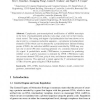Free Online Productivity Tools
i2Speak
i2Symbol
i2OCR
iTex2Img
iWeb2Print
iWeb2Shot
i2Type
iPdf2Split
iPdf2Merge
i2Bopomofo
i2Arabic
i2Style
i2Image
i2PDF
iLatex2Rtf
Sci2ools
BICOB
2009
Springer
2009
Springer
Computational Prediction of Genes Translationally Regulated by Cytoplasmic Polyadenylation Elements
Cytoplasmic post-transcriptional modification of mRNA transcripts in the form of polyadenylated (poly(A)) tails plays a key role in their translational control. The timing and degree of polyadenylation has been shown to be due in part to a consensus nucleotide sequence -- cytoplasmic polyadenylation elements (CPEs) which can be detected by a polyadenylation element binding protein (CPEB). An individual mRNA transcript controlled by CPEB may contain one or more CPE sites occurring upstream of a consensus hexamer poly(A) signal. A probabilistic model, CPEDetector, is presented for predicting whether or not a gene’s translation is mediated by CPEB. CPEDetector takes into account detected CPE sites, poly-A sites, and distance metrics between the detected locations. This approach is tested against the 3’ untranslated regions (UTRs) of known genes using the UTRdb database.
BICOB 2009 | Computational Biology | Cytoplasmic Post-transcriptional Modification | Mrna Transcript | Polyadenylation Element |
| Added | 24 Jul 2010 |
| Updated | 24 Jul 2010 |
| Type | Conference |
| Year | 2009 |
| Where | BICOB |
| Authors | Eric C. Rouchka, Xiangping Wang, James H. Graham, Nigel G. F. Cooper |
Comments (0)

